Arturia launched Pigments 6, a major update to its flagship software synthesizer. The latest version introduces significant enhancements to the virtual instrument's sound design capabilities.
The new Modal Engine is the centerpiece of this release. It lets musicians create physically inspired tones through collision and friction modeling. Users can craft sounds ranging from delicate plucked strings to expansive resonant pads, adding fresh dimensions to the synthesizer's hybrid architecture.
Arturia expanded the filtering options with three additions: an analog-inspired Multimode V2, a Cluster filter for textural effects, and a LoFi module for vintage-style processing. The company also integrated a vocoder effect, enabling both traditional vocal textures and experimental sound design through external input processing or internal engine routing.
The update brings four fresh modulation tools to enhance expressiveness. With the upgraded Function V2 modulator, musicians can assign different modulation values per voice, incorporate deeper randomization, trigger audio-driven envelope followers, and shape curves. The granular engine received notable improvements, adding mid-playback sample scanning, per-note grain randomization, and continuous grain size adjustment capabilities.
The interface underwent substantial refinement. It now features Quick Edit V2's streamlined drag-and-drop workflow, improved file navigation, and an updated layout with a polished light theme. These changes aim to enhance the creative process for music producers and sound designers.
Existing Pigments users can download this update at no cost and access special pricing on Explorations preset bundles. New customers benefit from introductory pricing on both the main software and expansion packs. The release maintains Pigments' foundation of six synthesis types, comprehensive modulation systems, professional-grade effects, and an advanced arpeggiator sequencer within its unified interface.
The new Modal Engine is the centerpiece of this release. It lets musicians create physically inspired tones through collision and friction modeling. Users can craft sounds ranging from delicate plucked strings to expansive resonant pads, adding fresh dimensions to the synthesizer's hybrid architecture.
Arturia expanded the filtering options with three additions: an analog-inspired Multimode V2, a Cluster filter for textural effects, and a LoFi module for vintage-style processing. The company also integrated a vocoder effect, enabling both traditional vocal textures and experimental sound design through external input processing or internal engine routing.
The update brings four fresh modulation tools to enhance expressiveness. With the upgraded Function V2 modulator, musicians can assign different modulation values per voice, incorporate deeper randomization, trigger audio-driven envelope followers, and shape curves. The granular engine received notable improvements, adding mid-playback sample scanning, per-note grain randomization, and continuous grain size adjustment capabilities.
The interface underwent substantial refinement. It now features Quick Edit V2's streamlined drag-and-drop workflow, improved file navigation, and an updated layout with a polished light theme. These changes aim to enhance the creative process for music producers and sound designers.
Existing Pigments users can download this update at no cost and access special pricing on Explorations preset bundles. New customers benefit from introductory pricing on both the main software and expansion packs. The release maintains Pigments' foundation of six synthesis types, comprehensive modulation systems, professional-grade effects, and an advanced arpeggiator sequencer within its unified interface.












